Reply 1180 of 2436, by pshipkov
Just checked on another UUD mobo. You are correct. Interesting i didnt cross this before.
Just checked on another UUD mobo. You are correct. Interesting i didnt cross this before.
Yes, even without the 1024K mod and when using regular FPM, NMI errors occur, particularly after a soft-reset.
Plan your life wisely, you'll be dead before you know it.
Probably the final chapter, for now at least, of my fastest 386 PC adventure - the IBM Blue Lighting 3 storyline.
It started on page 1 of this thread with PC-Chips M321 rev 2.3 motherboard and Am386DX-40 CPU.
Went through a lot of 386 mobos, including PCBs like Alaris Leopard and Cougar to finally settle on DTK PEM-4036Y with TI SXL2-50 CPU.
Along the way experimented with few IBM BL3 CPUs on weird adapter cards which never worked quite right, or at all, especially on fast motherboards.
This was very annoying because the BL3 chips scale much better than SXL2-50.
... until recently ...
It turns-out that IBM BL3 is pin compatible with 386DX.
Yes.
All these BL2/BL3 adapters made the whole upgrade thing a big mystery, to me at least.
I perceived the additional components and circuitry on them as a major incompatibility on electrical and signal level between 386 and BL3 chips.
So, never tried to plop a BL3 CPU on one of those QFP adapters. It felt ridiculous.
But in a unexpected turn of events i acquired such combo and surprise surprise - it worked.
Not only that, but it worked on the fast 386 motherboards and especially on that DTK PEM-4036Y.
Tried the same mod on two more BL3 chips - worked too.
Along the way noticed that BL3 chips scalability varies widely compared to the overall uniformity of Amd 386DX, Cyrix 486 DLC-40 and TI SXL2-50.
Image shows two of the chips modded in place already with a third one to go under the soldering iron on another donor adapter soon.
Included the frequency ranges of each chip.
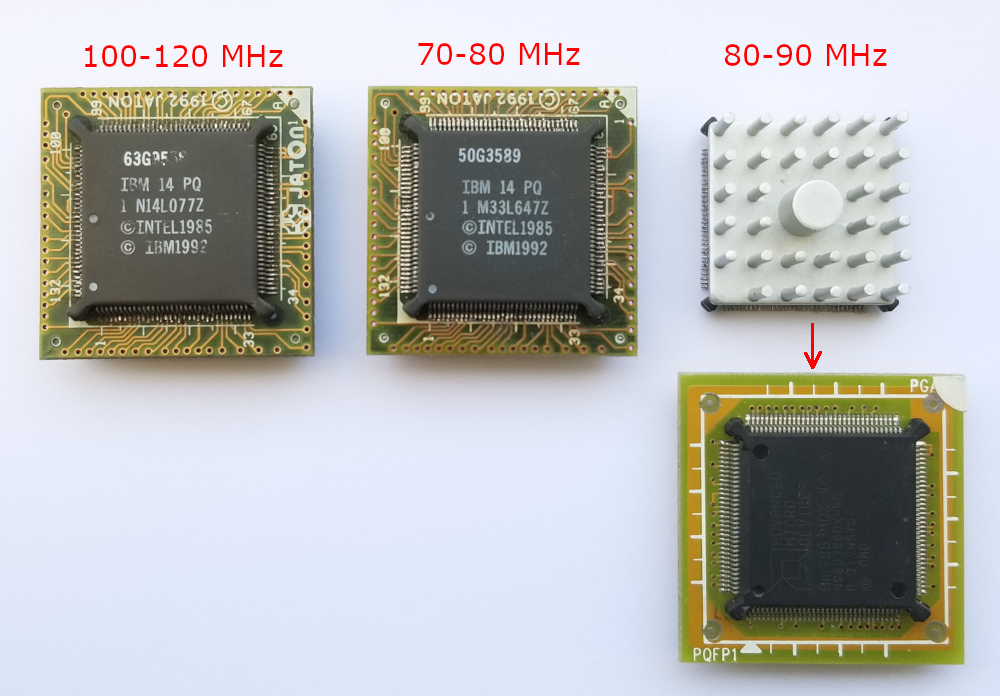
The best one got heatsink and fan strapped on top:
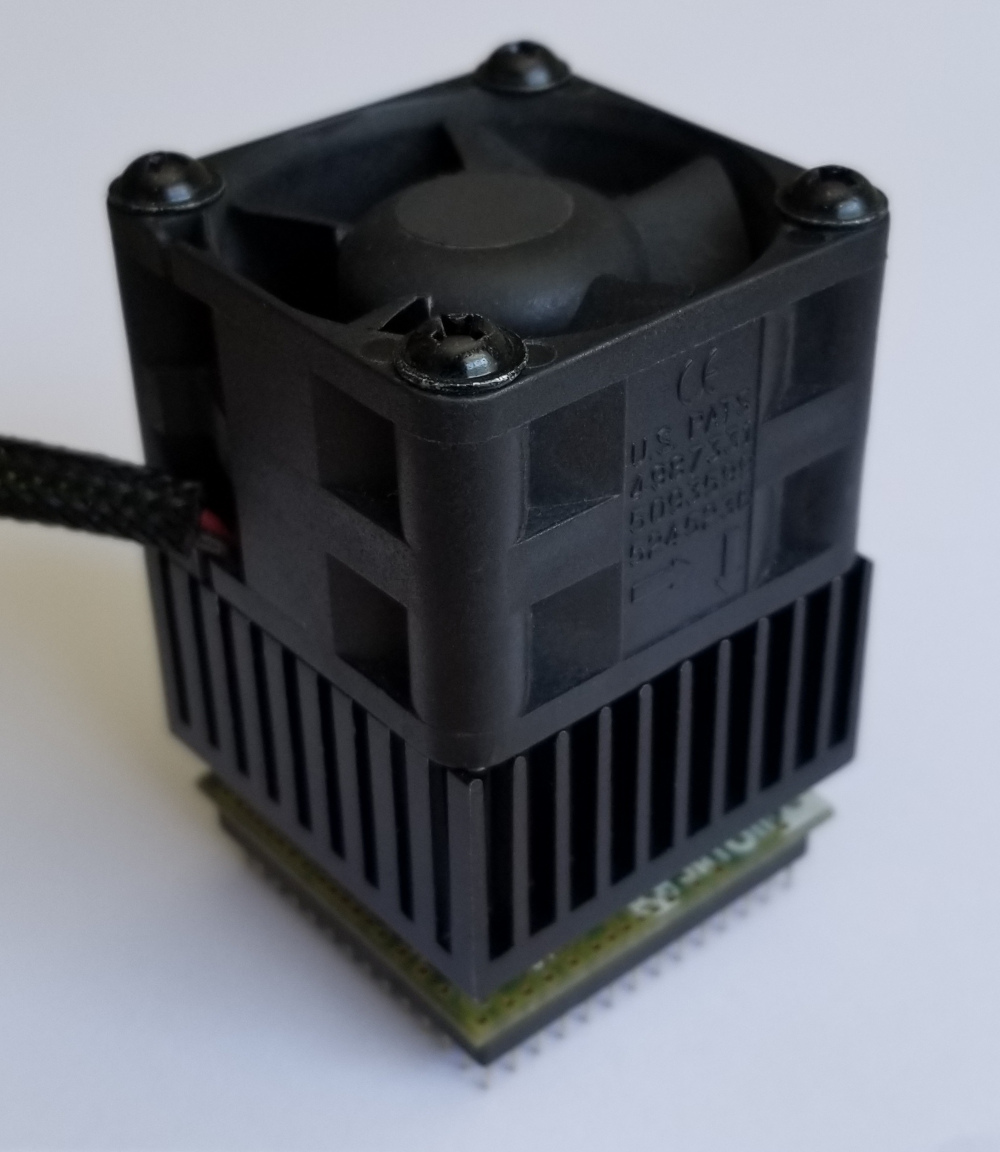
EDIT:
After series of grueling stability tests it was determined that air cooling can eventually fail when the ambient temperature is high enough (hot summer day).
Active cooling had to be applied. Used the same approach for getting the 486 processors long-term stable at 180/200MHz.
Fan, heatsink, 5V Peltier element, 2 layers of insulation for water condensation (foam on the inside + melted plastic on the outside), the CPU + adapter, custom 3D printed bracket.
Easy to disassemble, but very sturdy when strapped on.
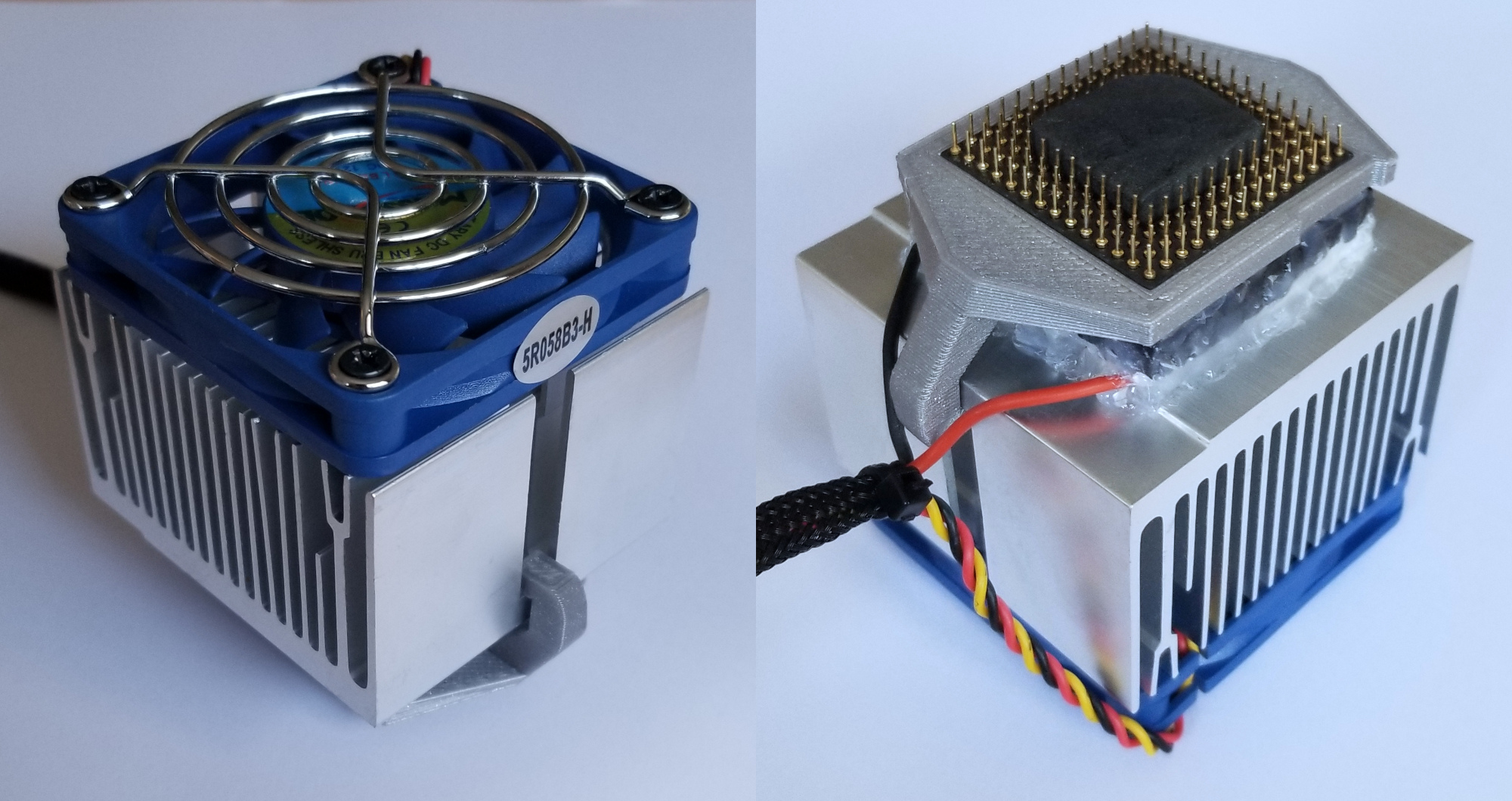
After swapping the SXL2-50 with BL3 CPU the rock solid system became flaky.
Random hangs, problems with local storage device access (CF-IDE adapter and card).
To combat these problems i had to:
- swap the 12ns rated ISSI L2 cache chips with 10ns rated WinBond ones.
- curate the RAM modules.
- switch the FPU from Cyrix FasMath CX-83D87-40-GP to ULSI DX/DLC 40 (details below)
- go through bunch of IDE controllers to finally find one that works stably - Promise EIDE Pro.
Current PC configuration:
motherboard: DTK PEM-4036Y
processor: IBM BL3 100MHz (2x50)
co-processor: ULSI DX/DLC 40
L2 cache: WinBond, 256Kb, 10ns
memory: LGS, 16Mb, 60ns
sound: SounbBlaster Pro 2
local storage: Promise EIDE Pro + CF adapter/card
LAN: Intel Ethernet 16-Bit LAN Adapter FA82595TX
video card: Diamond SpeedSTAR 64 ISA rev. A3 (Cirrus Logic GD-5434), 2Mb RAM
psu: 300W
input: keyboard, mouse
OS: DOS 6.22, Windows 3.11
Speedsys with the IDE controller listed above:
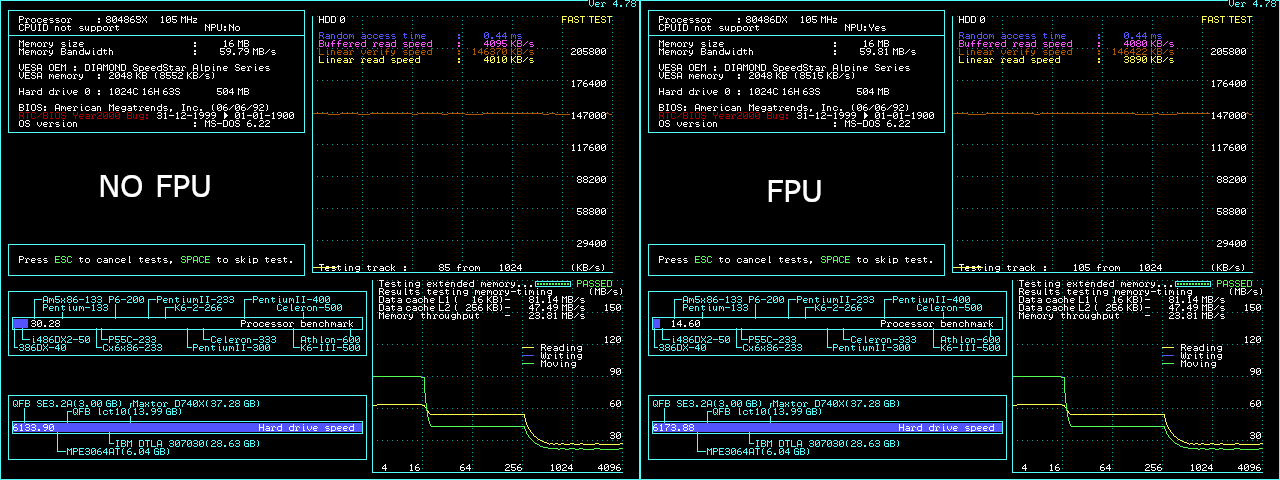
And with Adaptec AHA-1542CF with ZuluSCSI adapter:
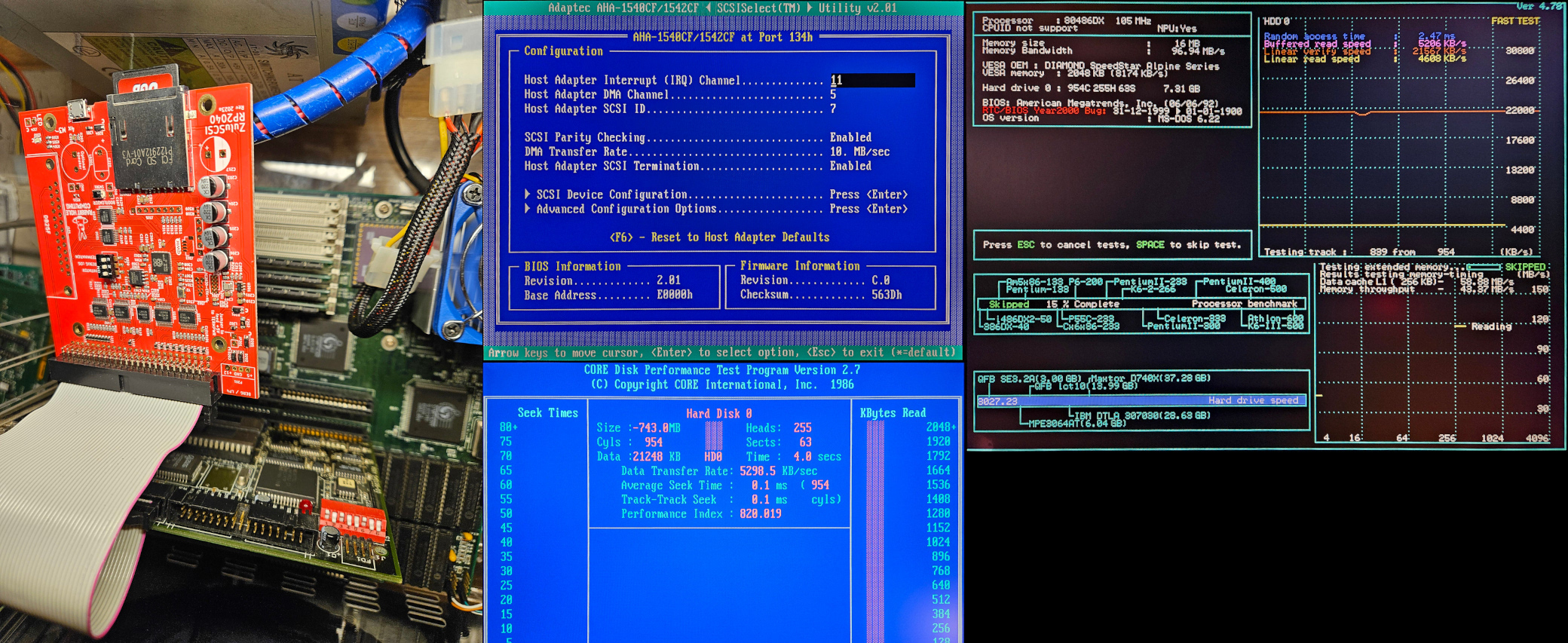
The usual set of tests.
DTK PEM + CL GD5343 + SXL2 at 50MHz (1x50) and ISA bus at 25MHz
DTK PEM + CL GD5343 + BL3 at 100MHz (2x50) and ISA bus at 25MHz <- !
Alaris Leopard with BL2 at 80MHz (2x40), Ark1000VL in DOS and S3 Trio64 in Windows
Alaris Cougar with BL3 at 100MHz (3x33, quite unstable) and 75MHz (3x25), Ark1000VL in DOS and S3 Trio64 in Windows
* Gray bars indicate not fully stable system.
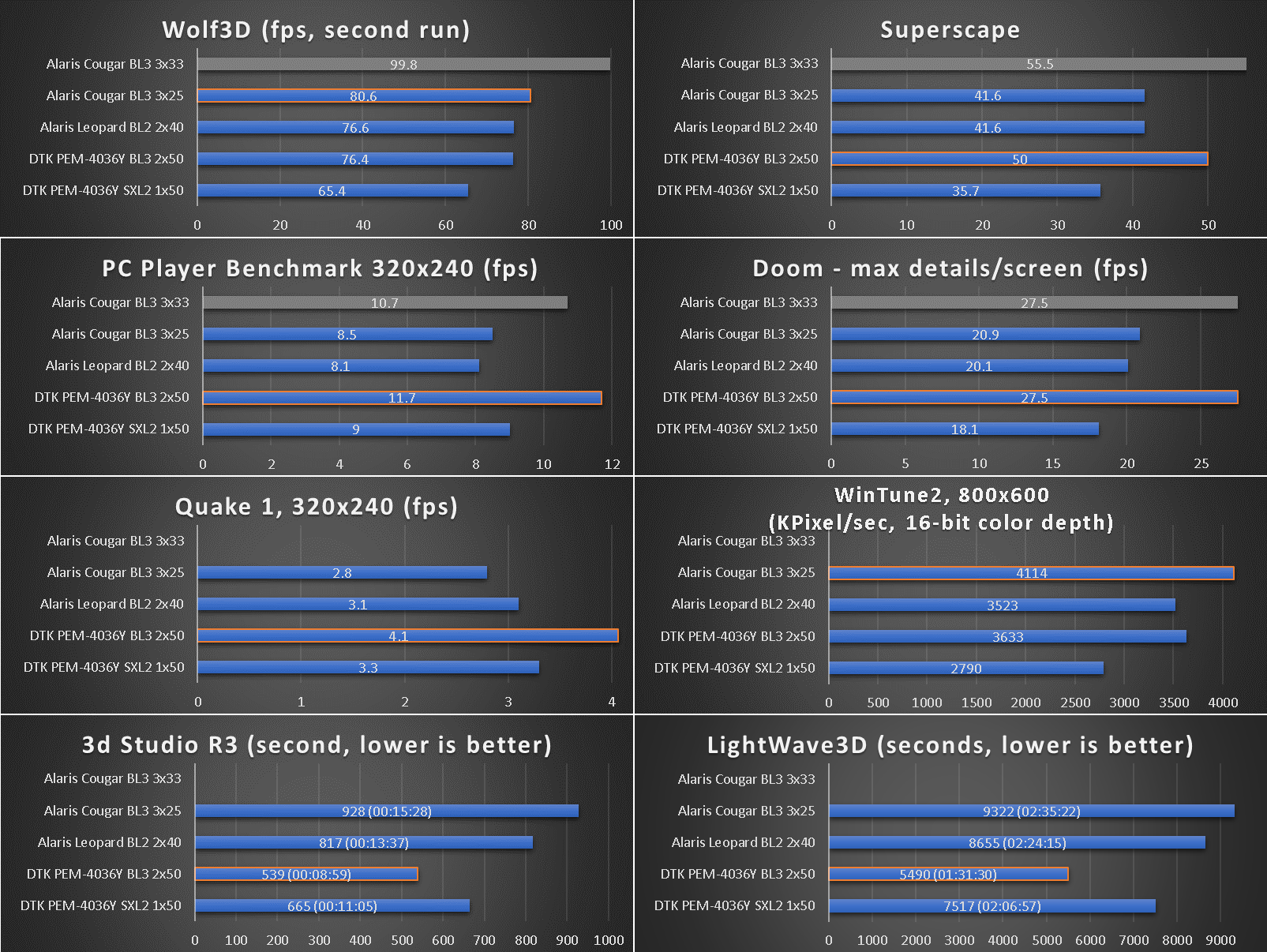
The Cougar board is a bit faster in Wolf3D, also leads by quite a bit in WinTune2 (Windows GUI) because of the S3 Trio 64 accelerator.
But other than that DTK PEM + BL3 is where things happen.
BL3 can cache 16Mb of RAM only.
Until now the 386 rig was running maxed-out with 32Mb but BL3 CPUs can cache only 16Mb. This means that performance drops significantly for any processes that touch memory addresses in the 16-32Mb range.
Limiting the installed RAM to 16Mb ensures best performance.
As mentioned above - the BL3 processor stressed the system more than what TI SXL2-50 did.
One of the side effects was FPU instabilities.
It became evident that the used until this point Cyrix FasMath CX-83D87-40-GP co-processor was not stable enough anymore - can hang the system in some of the complex computation tests.
Started searching for a replacement.
33MHz CPUs don't light-up at 50MHz frequency. This limited the scope to 40MHz rated ones. These guys:
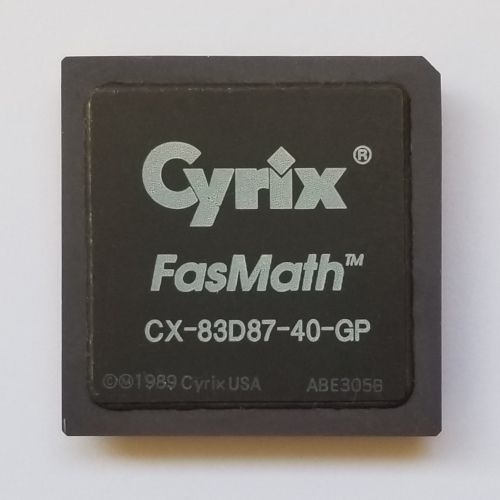
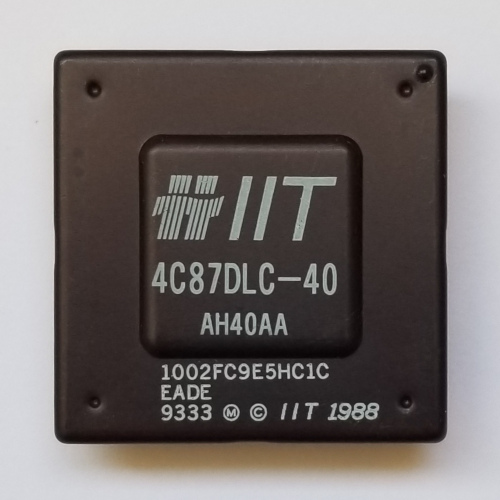
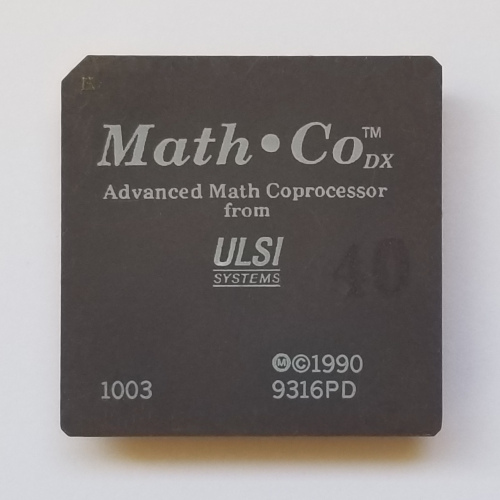
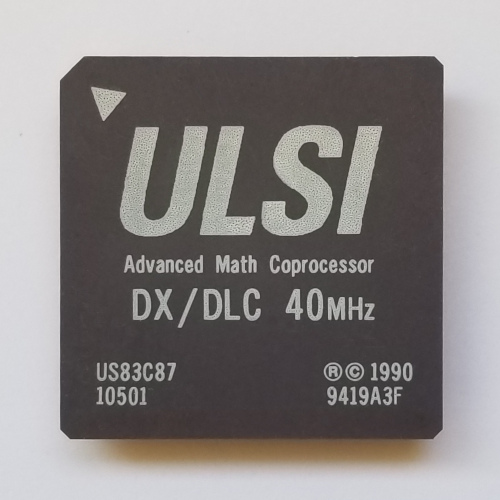
After a lot of testing it was determined that ULSI DX/DLC 40 fits the bill.
There were some interesting learnings along the way.
1. Stability with IBM BL3:
- ULSI Math.Co DX 40 is even less stable than Cyrix Fasmath 40. I have 2 of these ULSI FPUs and the statement applies to both of them.
- Cyrix Fasmath 40 is not fully stable with IBM BL3 (which caused this investigation in the first place).
- IIT's FPU is fully stable.
- ULSI DX/DLC 40 is fully stable.
2. Performance (consistent, relatively, with Am386DX / TI SXL2-50 / IBM BL3):
- The IIT FPU is slower than the rest in all tests and by quite a lot. This was unexpected.
- Cyrix FasMath and the two ULSI FPUs are on par in all tests ...
- ... but in Quake 1 ULSI DX/DLC pulls ahead. FasMath produces 3.9 fps ULSI DX/DLC pushes it to 4.1 fps. This effectively makes it a better option than Cyrix FasMath for 386 class systems.
Couple of screenshots:
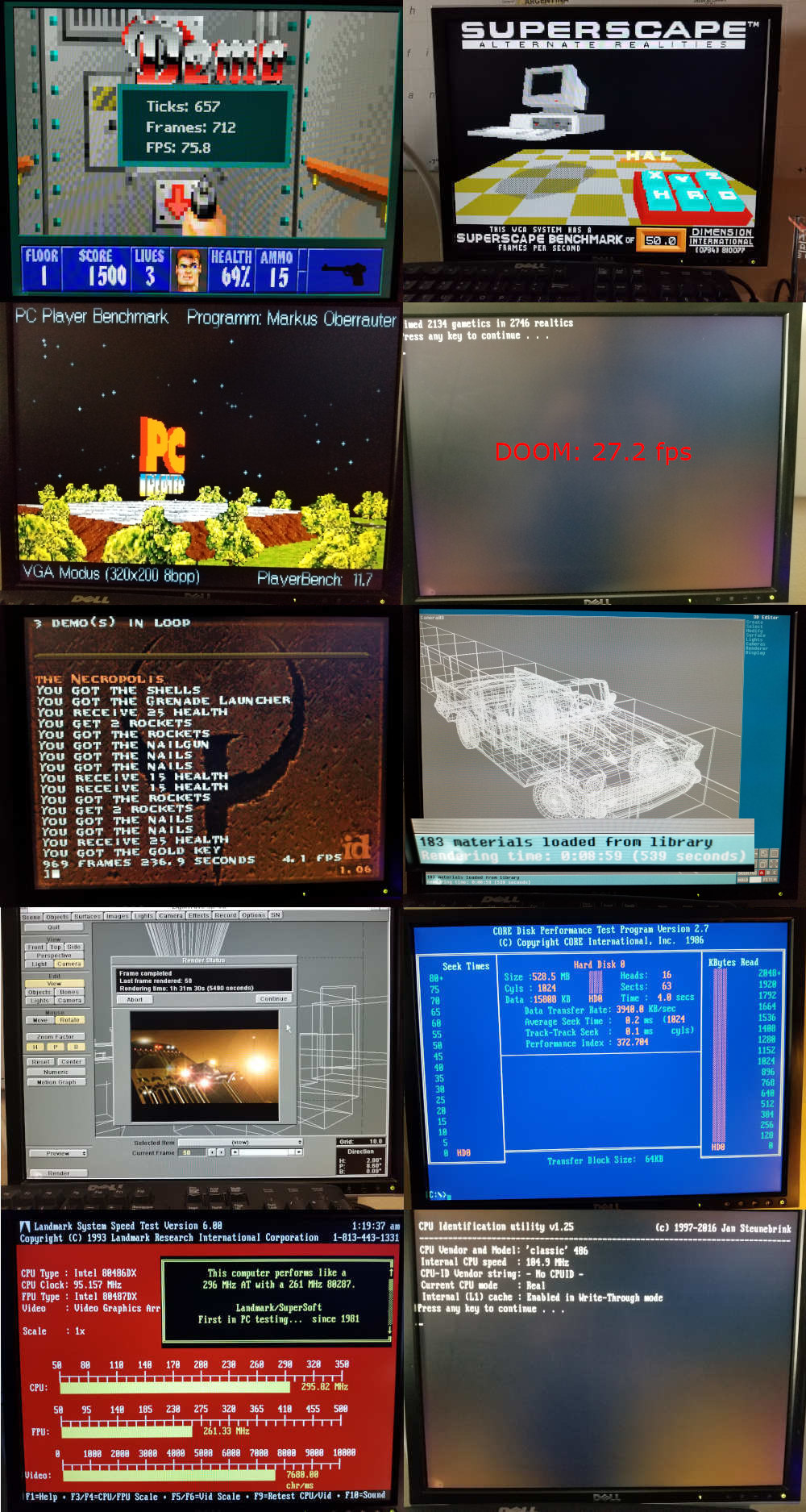
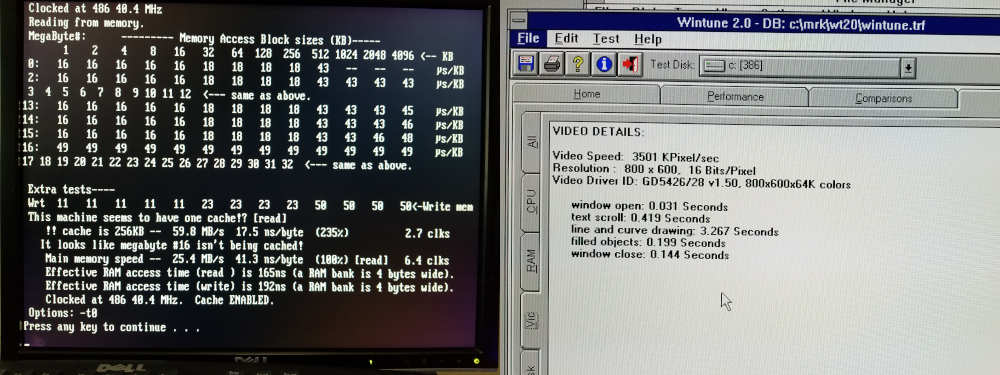
Quick roll captured on video.
(perf was further improved after capturing the video - numbers reflected in the screenshots above)
Notice that there is a discrepancy in the shown performance numbers between the benchmarks chart above and the screenshots/video.
The reason is that initially i used the REVTO486.SYS driver (screenshots/video).
Later on realized that LIGHT486.SYS + CTCHIP34.EXE produce better results in some tests without any side effects (benchmarks chart).
Details in this thread: Re: Creating a voltage regulated 386 BL3 module from existing parts
This whole QFP BL3 thing puts a new and interesting spin on the 386 upgrade paths - making everything much simpler and more affordable for those interested in the sport.
The contraptions worked on several other 386 motherboards with C&T, Symphony Haydn, UMC chipsets, but surprisingly didn't lit-up on Opti SX based mobo. This was unusual since Opti is epitome of compatibility.
Will explore in the coming weeks much more precisely what works where and to what extent.
One more vogon user confirmed on his side working BL3 on QFP adapter.
---
Something that may come later, we will see:
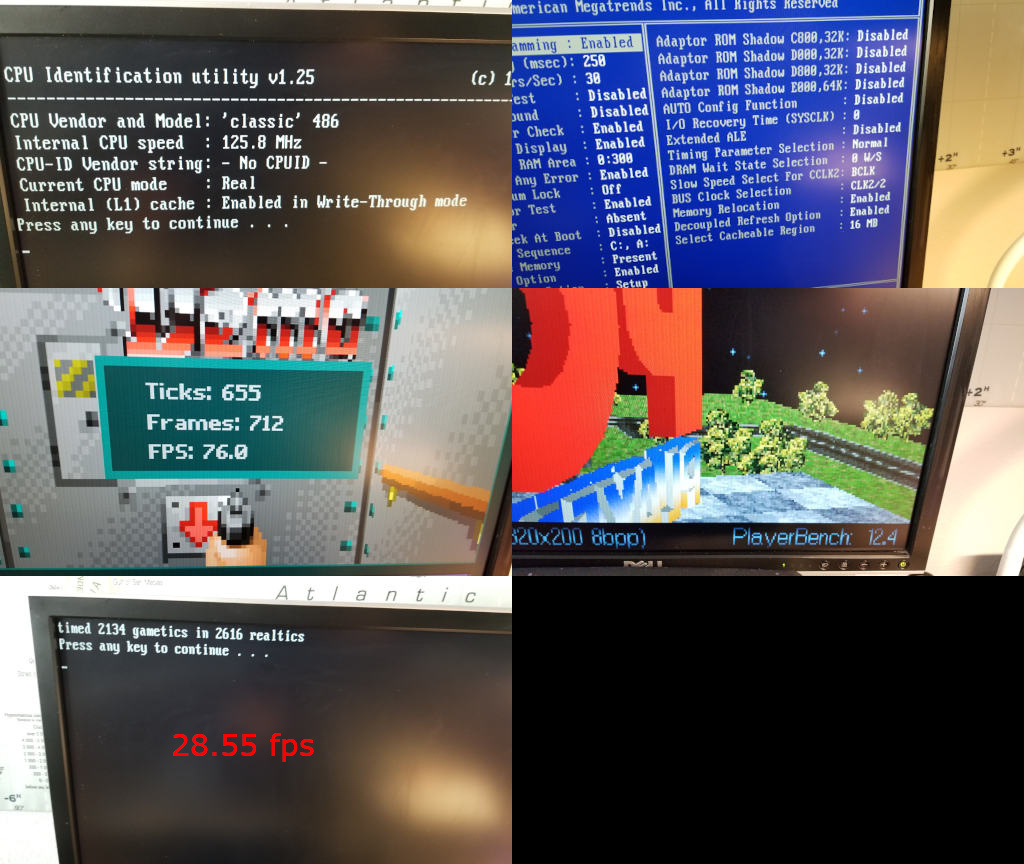
---
All data above has been added to the consolidated benchmark results chart.
You removed the ISSI 12 ns 256K L2 on the MB in favour of Winbond 10 ns rated L2. Were both the ISSI and Winbonds of the Chinese reproduction variety? Does this offer any reassurance that the Chinese fake modules may indeed be 10 ns ?
It is kind of a shame that your DTK Symphony Haydn based board doesn't have VLB slots. Adding VLB to the BL3 adds nice flavour and should greatly improve video response.
Any chance that putting your Jaton BL3 (the piece that runs at 2x50) onto your Alaris Cougar board would let it run stable at 3x33?
Between the Leapord and the Cougar, the Cougar looks faster. Any chance the Cougar would run at 2x40?
I'll also be testing such contraption in the months to come. Probably when summer concludes.
Plan your life wisely, you'll be dead before you know it.
Could you provide a cachechk or speedsys image to demonstrate that L1 cache is working? I was also wondering if you tested for DMA issues using sound or floppy access?
I was thinking about the voltage issue some. There are 14 Vcc pins on the 132-PQFP package: http://datasheets.chipdb.org/AMD/386/386SX/21020A.pdf ,
however in looking at the Jaton photos, I only see pins 22, 49, 58, and 99 actually have a trace coming out of them. I bet we could use a small VRM like this EZ1117
photo: https://blog.noq2.net/content/images/IMG_9583.jpg
datasheet: https://pdf1.alldatasheet.com/datasheet-pdf/v … ECH/EZ1117.html
and glue it to the underside, or the corner of the top face. Cut the re-route the four Vcc pins to the EZ1117A. This would provide a fixed 3.3V to the BL3.
Plan your life wisely, you'll be dead before you know it.
Updated the above post with additional FPU information - check it out.
I am sure you will find it interesting.
---
About L2 cache chips:
Long ago i stopped worrying about how real or fake these higher rated chips are.
The better rating hints to me that they were either manufactured to a higher standard, or possibly were tested and labeled accordingly.
At any rate - the 10/12ns chips tend to work better here than 15/20ns ones.
No idea if rating played any role or it was just a coincidence that the chips worked-out just because.
---
Floppy drives work.
At least Gotek floppy emulator does.
---
About DTK PEM + VLB sloth, Alaris Cougar notes, perf analysis:
Yes, it would be great for that DTK board to have VLB slot.
But also, looking at the benchmarks - all of them except Wolf3D and WinTune2 are CPU bound.
Wolf3D is lightweight enough for the CPU to produce enough frames so the ISA bus becomes the limit for transporting data to video memory. Notice how the Cougar board with VLB pulls quite ahead while DTK with its ISA falls behind, despite both CPUs running at 100MHz.
WinTune2 is dependent on GUI accelerated features, naturally S3 Trio64 stomps the CL-5434 ISA card by 600 KPixels/s. It is worth mentioning that this test does not carry a lot of weight in general. Lets say that all 800x600 pixels get redrawn from frame to frame (which is usually not the case but is worst case scenario) - that is 480,000 pixels or 480 KPixels, lets round it to 500 KPixels. The DTK board with CL-5435 pulls 3,500 KPixels per second. So that's 7 redraws per second, or 140ms for single full redraw - not bad. Cougar/S3 Trio64 get this down to 120ms. In reality GUI is redrawn partially, so this latency is easily half or even tenth of these worst case numbers.
---
About Alaris Cougar parameters:
The logic board can produce only 25/33MHz base frequency and 3x locked multiplier. Cannot remember measuring the BL3's VCC.
Was never able to get the system fully stable at 100MHz.
Can try 5V Peltier at some point later, but i have the nagging feeling the BL3 CPU is one of those unlucky ones that cannot climb there in the first place. If L1 cache is disabled 3x33 is stable.
In general after the recent success with the DTK board i kind of lost interest in the Alaris boards. Maybe one day will get back to the Cougar.
---
You have all the components already. Only time is needed.
Also, it will be interesting if you can hack the BIOS of your 386/VLB mobo to enable 2x multipliers. That's where perf $ is.
---
About Functioning L1/L2 caches:
They do work as expected, which was the biggest concern initially, but turned-out well. Satisfied with the outcome.
SpeedSys never worked on that DTK motherboard for some reason. Providing CCM screenshot which shows similar graphic representation of the mem perf.
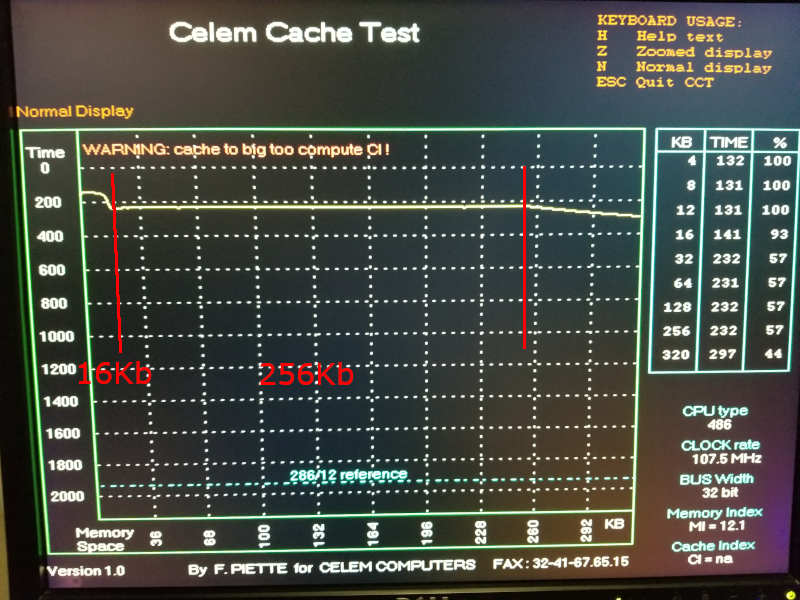
---
Aboout BL3 adapter with 3.3V mod:
VRM contraption is something that will be verified at some point later for sure.
Not sure 3.3V will be fully stable at 100 or more MHz, but still.
Wow, so you found a particular ULSI FPU stable at 50 MHz on this system. Was your Cyrix FasMath (dark grey top version) stable at 50 MHz on other motherboards?
Did you try running DOOM and Quake with sound enabled?
As for my Daewoo VLB 386 board, I'm pretty sure JakeThompson was kind enough to provide a rough sketch of how to add missing features in the AMI BIOS. After I get my Jaton, I might consider trying to unhide the BL3 1x/2x/3x option.
I've definitely run into situations in which Speedsys did not play nice with some of these obscure systems.
I was thinking about the BL3 mod some more and I might order some of those fixed 3.3 V regulators, and some adjustable. It may be that 3.6 or 3.7 V is more ideal for overclocking.
Plan your life wisely, you'll be dead before you know it.
feipoa wrote on 2022-06-22, 10:43:Wow, so you found a particular ULSI FPU stable at 50 MHz on this system. Was your Cyrix FasMath (dark grey top version) stable at 50 MHz on other motherboards?
the dark top FasMath was always stable at up to 50mhz on all systems i tried it on so far. on slow boards it can go to 55mhz.
but somehow became problematic with bl3 cpu. still the primary motivation for switching to ULSI DLC is the improved Quake 1 perf.
feipoa wrote on 2022-06-22, 10:43:Did you try running DOOM and Quake with sound enabled?
Full range of games, apps and peripheral hardware were examined to function properly, including these two games.
feipoa wrote on 2022-06-22, 10:43:As for my Daewoo VLB 386 board, I'm pretty sure JakeThompson was kind enough to provide a rough sketch of how to add missing features in the AMI BIOS. After I get my Jaton, I might consider trying to unhide the BL3 1x/2x/3x option.
Wonder why they locked it to a predefined value in a first place.
Cut on BIOS dev costs and QA for the different modes ...
feipoa wrote on 2022-06-22, 10:43:I was thinking about the BL3 mod some more and I might order some of those fixed 3.3 V regulators, and some adjustable. It may be that 3.6 or 3.7 V is more ideal for overclocking.
Link ?
It's all fine, but 486BL3 is a 3.3V part with 5V tolerant I/O. It gets damn hot even at 50MHz with 5V. I would cut all Vcc pins on the adaptor and use a DC-DC convertor to supply something under 4V.
> Not sure 3.3V will be fully stable at 100 or more MHz, but still.
Needs more than 3.3V for 100MHz, I have tried. It's only good up to 80MHz or so.
Been looking at this one.
The cpu in Alaris Cougar gets similarly hot. Didnt measure how many volts the mobo supplies to it. Also, didnt measure the temperature either, but on touch it feels the same to 5v interposer.
Lowering the voltage as much as possible will be the healthy thing to do for this silicon.
Can you share more details about your experiments ?
Thanks.
That one isn't up for the job. SX1308 is a step-up DC-DC convertor. You need a step-down one doing 5V to 3.3V or so. Look for Mini-360 or Mini-560, they can actually do 2A with a decent efficiency. There are many step-down linear regulators of course, but not so compact and the heat they produce has to be dealt with.
well that is a faceplant.
it is written all over that it is a step-up.
not really focusing on that atm, so using it as an excuse here.
I was thinking of these for the 3.3 V fixed part: https://www.ebay.ca/itm/392632814100
and these for the adjustable part: https://www.ebay.ca/itm/181847311430
They are certainly cheap enough. I'll try to make space on the PCB for the regulator. I'll start with the variable unit to find a sweet spot of voltage vs. MHz. I probably won't get to this for months though. My foundation work, that I'm doing solo, will go on for at least another month.
Plan your life wisely, you'll be dead before you know it.
Hi guys, been a few, somehow my notifications for this thread quit working and I’ve moved house and have had most of my collection boxed up for a bit.
Anyway, motivated by Pshipkov’s awesome 486 Quake score of 22.7 I wanted to double check my bios settings to see if I had left anything on the table. I’m able to consistently bench at 22.6 but discovered I can hit 22.7 if I flip the L1 cache mode with the TweakBios tool. It’s a bit odd as TweakBios detects I’ve got L1 set to WT. To achieve 22.7 I have to change the setting to WB, save, and change it back to WT, and save. Then bam, consistent 22.7 scores in Quake Dosbench.
First off all, what is happening here exactly?
Secondly, what’s the likelihood we could determine the bios setting the TweakBios tool is setting and mod it into the actual bios? This is on the MSI-4144 board which currently has no settings in the bios to adjust L1.
Very nice.
Can only imagine what kind of tweaking went in before you stumbled upon this peculiar method to squeeze the 0.1 fps out of Q1.
Is the system stable ?
How are the rest of the metrics with the standard tests we are using around here ?
Yes the system is quite stable, this is the same 200MHz AMD 5x86 rig I left off. I’ve managed to find a 32MB module with the same Micron chips this MSI board seems to prefer and it has really knocked out the inconsistent boot stability I was seeing.
I spent maybe an hour flipping the settings back and forth in the TweakBios tool before I figured out what was giving me that extra 0.1fps. I’ve also since discovered I can hit 22.7 without using the Tweak tool but it’s rare.
I’ve ran through the other usual tests and nothing besides Quake benefits, Speedsys and CacheCHK report the exact same memory speeds from previous numbers I’ve reported.
I’m hoping @feipoa might find some time to add the L1 cache write setting into the bios setup menu. Or perhaps give me some guidance.
@feipoa
Thanks for the links.
At some point i will be checking with variable volatage first, then can simplify it with something hardcoded.
@chadti99
Very nice.
I looked around to see the rest of the parameters of your msi system, but couldnt find them.
Can you remind me or provide a link ?
n.m.
Found them.
Glad you found it. Curious what is your preferred board for a 180MHz AMD 5x86 build? Has it shifted to the M919?
pshipkov, so you've ordered both of those items then? I did. Got 10 pieces each for like $2. What to do with all the extras? lol.
Chadti99, did you try using MODBIN to unhide any L1 settings? Could you provide a screenshot of the BIOS settings regarding cache? Could you remind me which BIOS and version you are using for the MS-4144? I recall there is an AMI and an AWARD option.
So you've tied the Quake 1 performance using MS-4144 against the LSD board? I guess I'll have to, at some point, test these out. pshipkov was kind enough to send me an Am5x86 that works at 180/200 MHz.
Concerning the 0.1 fps gain in Quake 1 when you are flipping between WB-WT, perhaps your test results are simply between significant figures, e.g. 22.64 comes up as 22.6 fps and 22.65 as 22.7 fps. Perhaps the fiddling with the L1 settings flushes the L1 cache before Quake loads, or does something else create the effect of "0.1 fps", which may very well be only 0.01 fps.
Plan your life wisely, you'll be dead before you know it.
@chadti99
So far the latest M919 revision with 1Mb L2 cache is coming ahead of everything else at 180MHz.
Downsides are weak onboard IDE controller and incompatibility with Voodoo3 PCI graphics cards.
You should check your MSI-4144 board at 180MHz (3x60) and see where it stands.
Its 4x50MHz performance is top notch, so good chance it does well at 180MHz as well.
I have 2 more 1Mb L2 cache SiS based mobos that need inspection. One from DTK another from Soyo.
Been thinking to inspect them at 180/200MHz. Just getting 11 10/12ns L2 cache chips working properly at these frequencies and tightest BIOS timings is a significant investment in time.
So keep delaying that activity for later and later.
It will be interesting to see if they can outdo the M919.
If you have time try MS-4144 and post results.
So far LuckyStar revision D is the most scalable 486 class mobo because of the 8ns L2 cache chips (from the hint provided by @ph4nt0m in the past).
@feipoa
I am currently in EU, so my retro-hardware activities are reduced to checking the forums from time to time.
Didn't think through the whole voltage dropping of the BL3 cpu/adapter.
I checked the links you provided, but didn't order anything yet.
Maybe better buy some from you, since you will have plenty of spares ?
Looks like Chadti99's Quake 1 score is really hitting the rounding error between 22.6 and 22.7 and small fluctuations in computation lead to hitting one or the other.
Not sure this is a BIOS setting from the sound of it.